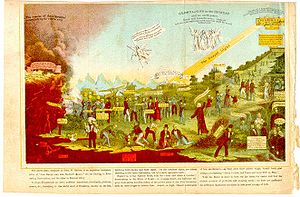- Matthew 7:14
-
Matthew 7:14 is the fourteenth verse of the seventh chapter of the Gospel of Matthew in the New Testament and is part of the Sermon on the Mount. This verse continues a metaphor begun in the previous one about the ease of following the wrong path.
In the King James Version of the Bible the text reads:
- Because strait is the gate, and narrow is the way, which
- leadeth unto life, and few there be that find it.
The World English Bible translates the passage as:
- How narrow is the gate, and restricted is the way
- that leads to life! Few are those who find it.
For a collection of other versions see BibRef Matthew 7:14
As with the word destruction in the previous verse, the word life seems to clearly have eschatological meaning. In other parts of Matthew the word life is used to stand for eternal salvation.
What is meant by restricted is somewhat in doubt. The term can be read to mean that the narrow route is overcrowded, but this contradicts the idea that only a few find it. Luz notes that it could imply that the route is a hard and difficult one to follow, as the sermon has implied the proper path is one of tribulation and suffering.[1] Another view is that the proper way is so narrow that it is difficult to find, and requires effort and searching to find.[2]
The metaphor in this verse implies that the path of sin is an easy one to follow, and that one will do so without conscious effort not to. Davies and Allison note that the notion of vice being a far easier path than virtue is a common one to most religions. The verse seems clear that it is only a minority that will find and follow God's path. While pessimistic, this is in keeping with Jewish thought, which traditionally saw the pious as a beleaguered minority in a world of sinners. In other parts of the Gospel, such as Matthew 8:11 and Mathew 20:28, Jesus does state that many are saved, so it can not be too small a number that find the narrow gate.[3]
References
- ^ Luz, Ulrich. Matthew 1-7: A Commentary. trans. Wilhlem C. Linss. Minneapolis: Augsburg Fortess, 1989.
- ^ Morris, Leon. The Gospel According to Matthew. Grand Rapids: W.B. Eerdmans, 1992.
- ^ Davies, W.D. and Dale C. Allison, Jr. A Critical and Exegetical Commentary on the Gospel According to Saint Matthew. Edinburgh : T. & T. Clark, 1988-1997.
Gospel of Matthew Preceded by:
Matthew 7:13Chapter 7 Followed by:
Matthew 7:15Categories:- Gospel of Matthew verses
- Sermon on the Mount
Wikimedia Foundation. 2010.

